In her essay reflecting on the situatedness of bodies in time and space, Sara Ahmed asks “what does it mean to be orientated?”. The answer to this question is dependent on the ecologies we are entangled in, and the interdependence between ourselves, others, sites and temporalities. To ask what it means to be orientated, according to Ahmed, is to ruminate upon “how it is that we come to find our way in a world that acquires new shapes, depending on which way we turn”.
Ecologies of Being is an exhibition that considers the ways in which we are enmeshed in a network of flows between beings, place, memory and time. The exhibition features ten artists who seek to move towards a deeper understanding of the ecologies they are embedded in and contingent upon. The works present insights into worlds that are corporeal, speculative, multi-faceted and in constant flux.
Where certain ways of understanding sites and histories rely on the conception of time as “homogenous and empty”, philosopher Walter Benjamin suggests that we understand these constructs rather as a “constellation overflowing with tensions” which we must attempt to grasp. This idea of a ‘constellation’crystallizes our relationship to space as lived- enmeshed with many histories, beings and forces of which we are both aware and unaware. It further reminds us that the spheres of our existence are riddled with frictions, complications, and a sense of unevenness in relation to the undercurrents of power that are never too far from the surface.
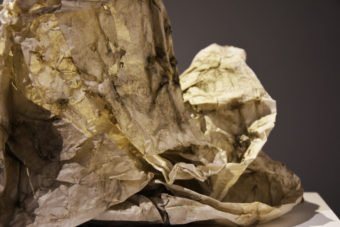
In Cindy Yuen-Zhe Chen’s work Sounding Langshi: Mountain, wenzhou paper is rubbed against rock formations in Guilin, Southern China, forming an imprint on the paper at the same time as the sound of the gesture is recorded from devices on the artist’s wrists. This process is an articulation of the bodily engagement with place, marking Chen’s interest in embodied listening and learning. Upon returning to Sydney, the paper was examined, quarantined and gamma irradiated, to destroy any potential living organic matter. This instance invokes questions of power and global mobility.
These notions are similarly present in Monisha Chippada’s video-installation Ilū, which offers a tender exploration of borders, alienation, and (be)longing. Ilūand Sounding Langshi demonstrate an interplay between roots (that is grounding, inheritance) and routes– the tracing of multi-directional paths and possibilities. Ultimately, for both artists, the consideration of sites and space is allowed through a reorientation towards being, more so than knowing.
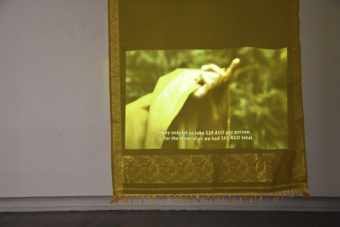
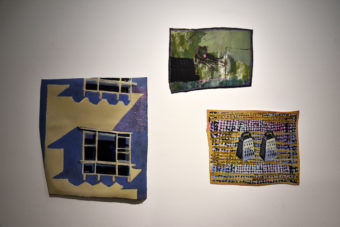
Ida Lawrence’s paintings form an ongoing series, informed by observations that the artist makes and records. An overheard conversation is quietly jotted down on paper, a memory or experience typed and edited in a Word document. Lawrence’s attentiveness to the world around her is portrayed in these visual anecdotes: recalling “a woman on her phone at 6:25 a.m., Departures Gate 2, Brisbane International Airport”, or how “my neighbours prop their window open with a book called The 7 Habits of Highly Effective People”. Through story-telling, tangents and mark making, Lawrence’s works serve as a palimpsest of daily existence.
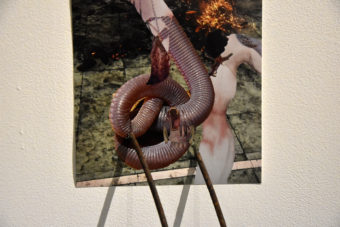
Sofiyah Ruqayah’s recent work bog bod reprise presents digital compositions of ethereal and mutating realities, imprinted with everyday vignettes, memories and intimate moments of connection. Serpentine, liquid forms converge and coalesce in the works. Amongst the collaged details we notice burnt coconut husks on grey tiles, a chicken foot hidden in the careful palettes. These layers form a kind of visual poetry– operating as an archive of memory, and stimulating more attentive ways of looking and being.
Louise Zhang’s work also enlists imagery of mutation, despite being made entirely from non-organic substances, including resin and polyfoam. In her series Feed you pink, Zhang has spawned glossy, bulbous objects that work to incite both attraction and disgust. This unstable matter– threatening to drip and ooze– sets our own memories and associations in motion.
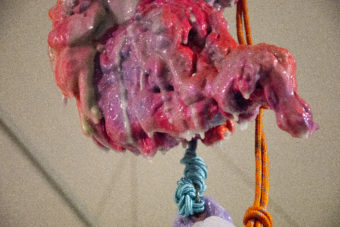
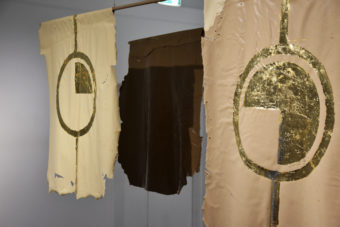
Material experimentation also influences the practice of Carmen Glynn-Braun, who expands the everyday substance of makeup into hanging installations. By pouring pools of makeup and allowing them several days to dry, Glynn-Braun creates ‘skins’ that are then hung in a gradation of hues. The most recent version is titled Complexion Conspiracy. Like its previous iterations, the work speaks to the brutality of Australian history wherein Aboriginal people were forcibly assimilated into the white-settler population, as an attempt to eliminate the First Nations people altogether. The patient and meditative process involved in the creation of the work offers space to continue healing from history.
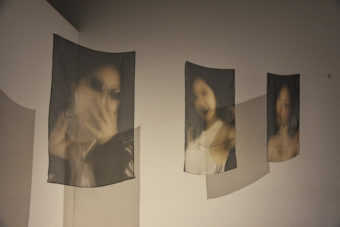
Gillian Kayrooz’s textile triptych series (including Guildford Is On The News Again, You Going Parra Late-Night? and Sunday’s Are Reserved For Marco Polo) personifies the artist’s experiences of her neighbourhood in Western Sydney. Printed on delicate organza, the characters constructed in Kayrooz’s work are an appropriation of the personas in her area: “myself, my neighbours, the girls I went to high school with, the rival school girls who hung around at Parramatta Westfield during late night shopping on Thursday evenings, the crowd who goes to Marco Polo on a Sunday”.
Jessica Bradford’s work similarly studies the personal and often complex ways in which space becomes encoded with memory. Her current practice focuses on Haw Par Villa: a bizarre theme park in Singapore created by the billionaire developers of Tiger Balm, a ubiquitous and multi-purpose ointment. The artist writes, “it is a site that occupies various temporalities, and is messily layered with personal experiences, collective memory, and history”. Bradford’s pieces, especially her drawings on primed aluminium, are materially disorientating; they are intricate, miniature treasures that evade the common impulse to define and categorise.
Whilst the archiving of memory and place play a significant role in Bradford’s Haw Par Villa series, the materiality of Bradford’s work allows it to transcend being merely an exhaustive archive, or sign of the past. Rather, the work can be seen as a dynamic (re)production– a reminder that places and objects are ‘alive’ and in a constant state of change.
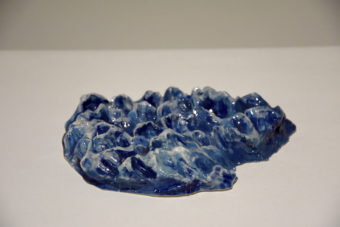
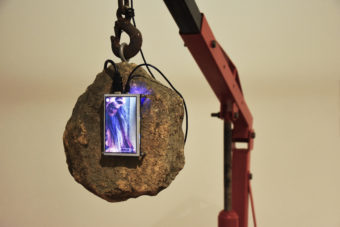
Kalanjay Dhir’s installation Planetary Anti-Aging Method #1 (PAAM-1) is a speculative technology envisioned in response to climate change and ecological disruption. PAAM-1 re-imagines the notable scene in the Hindu epic, Ramayana, where the inscription of Lord Rama’s name upon stone allows it to float. Dhir poses, if this technology could be applied to much larger land-masses, could it offer a solution to the steadily-rising sea levels? Works such as Dhir’s encapsulate the importance of speculative design. Beyond harnessing creativity as a means for problem-solving or trouble-shooting issues pertaining to the present, Dhir employs PAAM-1 as a technology that preempts and responds to near or alternate futures.
In various ways, the selected works in this exhibition trace the possibilities of disorientation as a tool for re-orienting ourselves in the world. Sonic gestures across landscape are recorded on paper; non-human, mutated forms intertwine; an artist and his grandfather are captured laughing in a fabricated instagram story from “8.76e+11 hours ago”. Such moments allow us to come closer to understanding the shapes or forms that our existence takes.
Essay by Tanushri Saha and Naomi Segal

